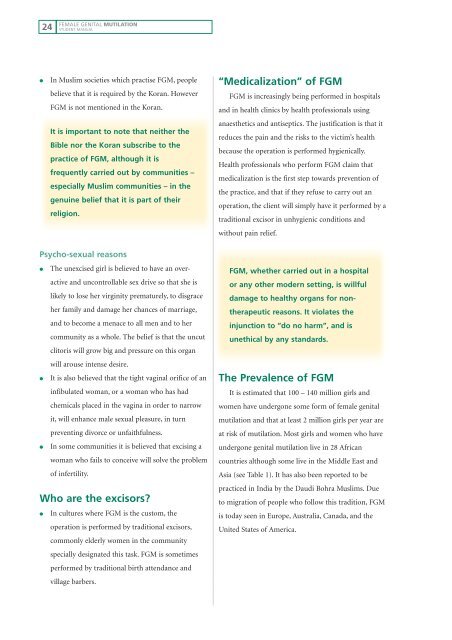Female Genital Mutilation - World Health Organization
Female Genital Mutilation - World Health Organization
Female Genital Mutilation - World Health Organization
Create successful ePaper yourself
Turn your PDF publications into a flip-book with our unique Google optimized e-Paper software.
24<br />
FEMALE GENITAL MUTILATION<br />
STUDENT MANUAL<br />
● In Muslim societies which practise FGM, people<br />
believe that it is required by the Koran. However<br />
FGM is not mentioned in the Koran.<br />
It is important to note that neither the<br />
Bible nor the Koran subscribe to the<br />
practice of FGM, although it is<br />
frequently carried out by communities –<br />
especially Muslim communities – in the<br />
genuine belief that it is part of their<br />
religion.<br />
Psycho-sexual reasons<br />
● The unexcised girl is believed to have an overactive<br />
and uncontrollable sex drive so that she is<br />
likely to lose her virginity prematurely, to disgrace<br />
her family and damage her chances of marriage,<br />
and to become a menace to all men and to her<br />
community as a whole. The belief is that the uncut<br />
clitoris will grow big and pressure on this organ<br />
will arouse intense desire.<br />
● It is also believed that the tight vaginal orifice of an<br />
infibulated woman, or a woman who has had<br />
chemicals placed in the vagina in order to narrow<br />
it, will enhance male sexual pleasure, in turn<br />
preventing divorce or unfaithfulness.<br />
● In some communities it is believed that excising a<br />
woman who fails to conceive will solve the problem<br />
of infertility.<br />
Who are the excisors?<br />
● In cultures where FGM is the custom, the<br />
operation is performed by traditional excisors,<br />
commonly elderly women in the community<br />
specially designated this task. FGM is sometimes<br />
performed by traditional birth attendance and<br />
village barbers.<br />
“Medicalization” of FGM<br />
FGM is increasingly being performed in hospitals<br />
and in health clinics by health professionals using<br />
anaesthetics and antiseptics. The justification is that it<br />
reduces the pain and the risks to the victim’s health<br />
because the operation is performed hygienically.<br />
<strong>Health</strong> professionals who perform FGM claim that<br />
medicalization is the first step towards prevention of<br />
the practice, and that if they refuse to carry out an<br />
operation, the client will simply have it performed by a<br />
traditional excisor in unhygienic conditions and<br />
without pain relief.<br />
FGM, whether carried out in a hospital<br />
or any other modern setting, is willful<br />
damage to healthy organs for nontherapeutic<br />
reasons. It violates the<br />
injunction to “do no harm”, and is<br />
unethical by any standards.<br />
The Prevalence of FGM<br />
It is estimated that 100 – 140 million girls and<br />
women have undergone some form of female genital<br />
mutilation and that at least 2 million girls per year are<br />
at risk of mutilation. Most girls and women who have<br />
undergone genital mutilation live in 28 African<br />
countries although some live in the Middle East and<br />
Asia (see Table 1). It has also been reported to be<br />
practiced in India by the Daudi Bohra Muslims. Due<br />
to migration of people who follow this tradition, FGM<br />
is today seen in Europe, Australia, Canada, and the<br />
United States of America.

















